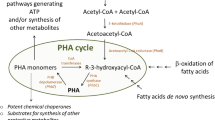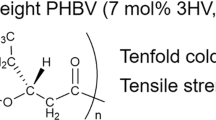Abstract
Polyhydroxyalkanoates (PHA) are storage polymers accumulated by numerous prokaryotes in form of intracellular granules. Native PHA granules are formed by amorphous polymer which reveals considerably higher elasticity and flexibility as compared to crystalline pure PHA polymers. The fact that bacteria store PHA in amorphous state has great biological consequences. It is not clear which mechanisms protect amorphous polymer in native granules from transition into thermodynamically favorable crystalline state. Here, we demonstrate that exposition of bacterial cells to particular stressors induces granules aggregation, which is the first but not sufficient condition for PHA crystallization. Crystallization of the polymer occurs only when the stressed bacterial cells are subsequently dried. The fact that both granules aggregation and cell drying must occur to induce crystallization of PHA indicates that both previously suggested hypotheses about mechanisms of stabilization of amorphous state of native PHA are valid and, in fact, both effects participate synergistically. It seems that the amorphous state of the polymer is stabilized kinetically by the low rate of crystallization in limited volume in small PHA granules and, moreover, water present in PHA granules seems to function as plasticizer protecting the polymer from crystallization, as confirmed experimentally for the first time by the present work.








Similar content being viewed by others
References
Arrondo JLR, Muga A, Castresana J, Goni FM (1993) Quantitative studies of the structure of proteins in solution by Fourier-transform infrared-spectroscopy. Prog Biophys Mol Biol 59(1):23–56. https://doi.org/10.1016/0079-6107(93)90006-6
Bair HE, Johnson GE, Anderson EW, Matsuoka S (1981) Non equilibrium annealing behavior of poly(vinyl acetate): phase diagram, thermal and crystallization behavior. Polym Eng Sci 21:930–935. https://doi.org/10.1002/pen.760211410
Beeby M, Cho M, Stubbe JA, Jensen GJ (2012) Growth and localization of polyhydroxybutyrate granules in Ralstonia eutropha. J Bacteriol 194(5):1092–1099. https://doi.org/10.1128/JB.06125-11
Bonthrone KM, Clauss J, Horowitz DM, Hunter BK, Sanders JKM (1992) The biological and physical-chemistry of Polyhydroxyalkanoates as seen by NMR-spectroscopy. FEMS Microbiol Lett 103(2-4):269–277. https://doi.org/10.1111/j.1574-6968.1992.tb05848.x
Bresan S, Sznajder A, Hauf W, Forchhammer K, Pfeiffer D, Jendrossek D (2016) Polyhydroxyalkanoate (PHA) granules have no phospholipids. Sci Rep 6:26612. https://doi.org/10.1038/srep26612
Byler DM, Susi H (1986) Examination of the secondary structure of proteins by deconvolved Ftir spectra. Biopolymers 25(3):469–487. https://doi.org/10.1002/bip.360250307
Ceccorulli G, Pizzoli M, Scandola M (1992) Plasticization of bacterial poly(3-Hydroxybutyrate). Macromolecules 25:3304–3306. https://doi.org/10.1021/ma00038a045
Choi JS, Park WH (2004) Effect of biodegradable plasticizers on thermal and mechanical properties of poly(3-hydroxybutyrate). Polym Test 23:455–460. https://doi.org/10.1016/j.polymertesting.2003.09.005
De Koning GJM, Lemstra PJ (1992) The amorphous state of bacterial poly[(R)-3-hydroxyalkanoate] in vivo. Polymer 33:3292–3294. https://doi.org/10.1016/0032-3861(92)90249-V
Goormaghtigh E, Cabiaux V, Ruysschaert JM (1990) Secondary structure and dosage of soluble and membrane proteins by attenuated total reflection Fourier-transform infrared spectroscopy on hydrated films. Eur J Biochem 193(2):409–420. https://doi.org/10.1111/j.1432-1033.1990.tb19354.x
Hu Y, Zhang J, Sato H, Noda I, Ozaki Y (2007) Multiple melting behavior of poly(3-hydroxybutyrate-co-3-hydroxyhexanoate) investigated by differential scanning calorimetry and infrared spectroscopy. Polymer 48:4777–4785. https://doi.org/10.1016/j.polymer.2007.06.016
Jendrossek D (2007) Peculiarities of PHA granules preparation and PHA depolymerase activity determination. Appl Microbiol Biotechnol 74(6):1186–1196. https://doi.org/10.1007/s00253-007-0860-9
Kadouri D, Jurchevitch E, Okon Y (2003) Involvement of the reserve material poly-β-hydroxybutyrate in Azospirillum brasilense stress endurance and root colonization. Appl Environ Microbiol 69(6):3244–3250. https://doi.org/10.1128/AEM.69.6.3244-3250.2003
Kim J, Kim YJ, Choi SY, Lee SY, Kim KJ (2017a) Crystal structure of Ralstonia eutropha polyhydroxyalkanoate synthase C-terminal domain and reaction mechanisms. Biotechnol J 12(1):1600648. https://doi.org/10.1002/biot.201600648
Kim YJ, Choi SY, Kim J, Jin KS, Lee SY, Kim KJ (2017b) Structure and function of the N-terminal domain of Ralstonia eutropha polyhydroxyalkanoate synthase, and the proposed structure and mechanisms of the whole enzyme. Biotechnol J 12(1):1600649. https://doi.org/10.1002/biot.201600649
Koskimäki JJ, Kajula M, Hokkanen J, Ihantola EL, Kim JH, Hautajärvi H, Hankala E, Suokas M, Pohjanen J, Podolich O, Kozyrovska N, Turpeinen A, Pääkkönen M, Mattila S, Campbell BC, Pirttilä AM (2016) Methyl-esterified 3-hydroxybutyrate oligomers protect bacteria from hydroxyl radicals. Nat Chem Biol 12(5):332–338. https://doi.org/10.1038/nchembio.2043
Lauzier C, Marchessault RH, Smith P, Chanzy H (1992a) Structural study of isolated poly(β-hydroxybutyrate) granules. Polymer 33:823–827. https://doi.org/10.1016/0032-3861(92)90343-U
Lauzier C, Revol JF, Marchessault RH (1992b) Topotactic crystallization of isolated poly(beta-hydroxybutyrate) granules from Alcaligenes eutrophus. FEMS Microbiol Lett 103:299–310. https://doi.org/10.1111/j.1574-6968.1992.tb05851.x
Mas J, Pedros-Alio C, Guerrero R (1985) Mathematical-model for determining the effects of intracytoplasmic inclusions on volume and density of microorganisms. J Bacteriol 164:749–756
Nowroth V, Marquar L, Jendrossek D (2016) Low temperature-induced viable but not culturable state of Ralstonia eutropha and its relationship to accumulated polyhydroxybutyrate. FEMS Microbiol Lett 363(23):fnw249. https://doi.org/10.1093/femsle/fnw249
Obruca S, Snajdar O, Svoboda Z, Marova I (2013) Application of random mutagenesis to enhance the production of polyhydroxyalkanoates by Cupriavidus necator H16 on waste frying oil. World J Microbiol Biotechnol 29(12):2417–2428. https://doi.org/10.1007/s11274-013-1410-5
Obruca S, Sedlacek P, Krzyzanek V, Mravec F, Hrubanova K, Samek O, Kucera D, Benesova P, Marova I (2016a) Accumulation of Poly(3-hydroxybutyrate) helps bacterial cells to survive freezing. PLoS One 11:e0157778. https://doi.org/10.1371/journal.pone.0157778
Obruca S, Sedlacek P, Mravec F, Samek O, Marova I (2016b) Evaluation of 3-hydroxybutyrate as an enzyme-protective agent against heating and oxidative damage and its potential role in stress response of poly(3-hydroxybutyrate) accumulating cells. Appl Microbiol Biotechnol 100:1365–1376. https://doi.org/10.1007/s00253-015-7162-4
Obruca S, Sedlacek P, Mravec F, Krzyzanek V, Nebesarova J, Samek O, Kucera D, Benesova P, Hrubanova K, Milerova M, Marova I (2017) The presence of PHB granules in cytoplasm protects non-halophilic bacterial cells against the harmful impact of hypertonic environments. New Biotechnol 39:68–80. https://doi.org/10.1016/j.nbt.2017.07.008
Obruca S, Sedlacek P, Koller M, Kucera D, Pernicova I (2018) Involvement of polyhydroxyalkanoates in stress resistance of microbial cells: biotechnological consequences and applications. Biotechnol Adv 36(3):856–870. https://doi.org/10.1016/j.biotechadv.2017.12.006
Pavez P, Castillo JL, Gonzalez C, Martinez M (2009) Poly-β-hydroxyalkanoate exert a protective effect against carbon starvation and frozen conditions in Sphingopyxis chilensis. Curr Microbiol 59:636–640. https://doi.org/10.1007/s00284-009-9485-9
Porter M, Yu J (2011a) Monitoring the in situ crystallization of native biopolyester granules in Ralstonia eutropha via infrared spectroscopy. J Microbiol Methods 87(1):49–55. https://doi.org/10.1016/j.mimet.2011.07.009
Porter M, Yu J (2011b) Crystallization kinetics of poly(3-hydroxybutyrate) granules in different environmental conditions. J Biomater Nanobiotechnol 2:301–310. https://doi.org/10.4236/jbnb.2011.23037
Sedlacek P, Slaninova E, Koller M, Nebesarova J, Marova I, Krzyzanek V, Obruca S (2018) PHA granules help bacterial cells to preserve cell integrity when exposed to sudden osmotic imbalances. New Biotechnol. https://doi.org/10.1016/j.nbt.2018.10.005
Slaninova E, Sedlacek P, Mravec F, Mullerova L, Samek O, Koller M, Hesko O, Kucera D, Marova I, Obruca S (2018) Light scattering on PHA granules protects bacterial cells against the harmful effects of UV. Appl Microbiol Biotechnol 102(4):1923–1931. https://doi.org/10.1007/s00253-018-8760-8
Soto G, Setten L, Lisi C, Maurelis C, Mozzicafreddo M, Cuccioloni M, Angeletti M, Ayub ND (2012) Hydroxybutyrate prevents protein aggregation in the halotolerant bacterium Pseudomonas sp. CT13 under abiotic stress. Exremophiles 16:455–462. https://doi.org/10.1007/s00792-012-0445-0
Sudesh K, Abe H, Doi Y (2000) Synthesis, structure and properties of polyhydroxyalkanoates: biological polyesters. Prog Polym Sci 25:1503–1555. https://doi.org/10.1016/S0079-6700(00)00035-6
Susi H, Byler DM (1986) Resolution-enhanced fourier transform infrared. Methods Enzymol 130:290–311. https://doi.org/10.1016/0076-6879(86)30015-6
Uchino K, Saito T, Jendrossek D (2008) Poly(3-hydroxybutyrate) (PHB) depolymerase PhaZa1 is involved in mobilization of accumulated PHB in Ralstonia eutropha H16. Appl Environ Microbiol 74(4):1057–1063. https://doi.org/10.1128/AEM.02342-07
Wang Q, Yu H, Xia Y, Kang Z, Qi Q (2009) Complete PHB mobilization in Escherichia coli enhances the stress tolerance: a potential biotechnological application. Microb Cell Factories 8:47. https://doi.org/10.1186/1475-2859-8-47
Wieczorek R, Pries A, Steinbuchel A, Mayer F (1995) Analysis of a 24-kilodalton protein associated with the polyhydroxyalkanoic acid granules in Alcaligenes eutrophus. J Bacteriol 177:2425–2435. https://doi.org/10.1128/jb.177.9.2425-2435.1995
Wittenborn EC, Jost M, Wei Y, Stubbe J, Drennan CL (2016) Structure of the catalytic domain of the class I polyhydroxybutyrate synthase from Cupriavidus necator. J Biol Chem 291:25264–25277. https://doi.org/10.1074/jbc.M116.756833
York GM, Lupberger J, Tian J, Lawrence AG, Stubbe JA, Sinskey AJ (2003) Ralstonia eutropha H16 encodes two and possibly three intracellular poly[D-(-)-3-hydroxybutyrate] depolymerase genes. J Bacteriol 185(13):3788–3794. https://doi.org/10.1128/JB.185.13.3788-3794.2003
Zhao YH, Li HM, Qin LF, Wang HH, Chen GQ (2007) Disruption of the polyhydroxyalkanoate synthase gene in Aeromonas hydrophila reduces its survival ability under stress conditions. FEMS Microbiol Lett 276:34–41. https://doi.org/10.1111/j.1574-6968.2007.00904.x
Acknowledgements
We acknowledge the program for large research infrastructures of the Ministry of Education, Youth and Sports within the project “National Infrastructure for Biological and Medicinal Imaging (Czech-Biolmaging LM2015062).
Funding
This study was funded by the projects “Materials Research Centre at FCH BUT - Sustainability and Development” No. LO1211 and “National Infrastructure for Biological and Medicinal Imaging” (Czech-Biolmaging LM2015062) of the Ministry of Education, Youth and Sports of the Czech Republic and by the project GP19-20697S of the Czech Science Foundation (GACR).
Author information
Authors and Affiliations
Corresponding author
Ethics declarations
Conflict of interest
The authors declare that they have no conflict of interest.
Ethical approval
This article does not contain any studies with human participants or animals performed by any of the authors.
Additional information
Publisher’s Note
Springer Nature remains neutral with regard to jurisdictional claims in published maps and institutional affiliations.
Electronic supplementary material
ESM 1
(PDF 7510 kb)
Rights and permissions
About this article
Cite this article
Sedlacek, P., Slaninova, E., Enev, V. et al. What keeps polyhydroxyalkanoates in bacterial cells amorphous? A derivation from stress exposure experiments. Appl Microbiol Biotechnol 103, 1905–1917 (2019). https://doi.org/10.1007/s00253-018-09584-z
Received:
Revised:
Accepted:
Published:
Issue Date:
DOI: https://doi.org/10.1007/s00253-018-09584-z




